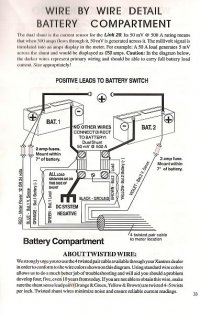Batteries
That is exacty how I have my electrical system set up including the Blue Seas panel. The only difference is I dont have the Solar Panel. Its been working great, but I ultimately want to upgrade my house bank, get my alternator rebuilt or replaced, and possibly add a small inverter to run a better coffee pot and or a small flat panel tv. Ron I need to do the same panel rewire. Thinking about taking it on this winter but.... Its really the end game for my electrical system as I have done all the other upgrades you mentioned. Curious to know how big your house bank is, and where it is located? I am guessing its under the aft cabin bunk as your 38 is an earlier model than mine.
Yes ,my batteries are under the front edge of the quarter berth, behind the nav sation seat and in front of the fuel tank bulkhead. I have two group 31 gel cells and a group 24 gel cell starting battery shoehorned in there. I often think that I want more battery capacity but then I'm not sure it's worth the remodeling. The gel cells give me fast charging rates, no maintenance, and good capacity for their size. Next time I'll consider AGMs just because they give a few more amp hours for the G31 size case.
We typically cruise the Bahamas from December through May and so far this set up works fine. We run about 40 to 50 amp hour deficits (net after solar input) on a typical day and run our engine about an hour to an hour and a half each day to recover that. Normal sailing days often include at least that much motoring anyway. Bigger batteries wouldn't change that much. Our biggest power hog is the fridge which is on all the time followed by the Lectra-san unit ... probably eating less would save us amps as well as pounds.
We installed a Xantrex 1800 watt inverter this summer. (we put it under the nav station seat) We'll see how that goes. It has a built in transfer switch and we have it wired to the main AC panel so all of our outlets are live when it's on. We have a microwave where the oven should be and the inverter will run it provided the engine's running. We don't expect to use it much ... mostly it stores pots and pans. We've learned to get by without an oven over the years ... just heats up the cabin too much anyway.
The inverter mainly supplies power for various chargers, the computer ... and a small flat screen TV that when wired to the computer also plays DVDs but it's also useful for power tools like my Dremel or a corded drill. I make my coffee by boiling water in a teapot on the stove then pouring it through a Melitta filter directly into my mug. The wife uses the same hot water for her tea. Works for us.
We've thought about blenders, breadmakers, and coffee makers but we really can't give space away for such single use tools. Generally things on our boat have to serve more than one purpose or be particularly useful.
I'd be interested in what you end up doing for your panel wiring project, I'll be taking that one on next season I expect.


 ) they are a potential disaster waiting to happen. I had my little adventure with the charger cables a few weeks ago, and from now on everything will be fused.
) they are a potential disaster waiting to happen. I had my little adventure with the charger cables a few weeks ago, and from now on everything will be fused.
